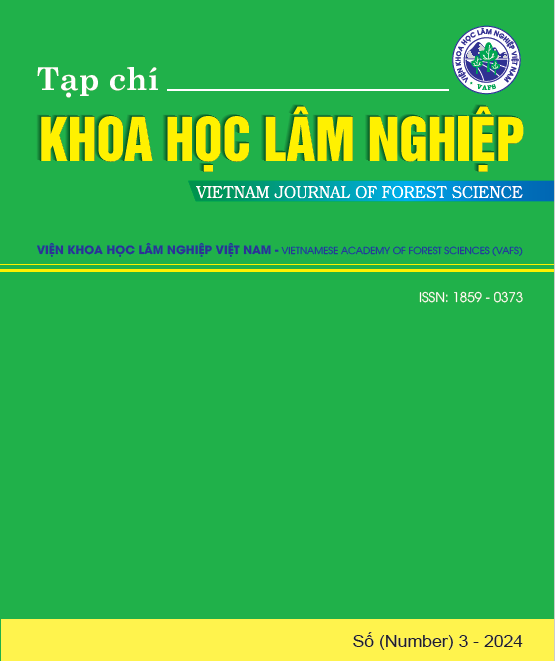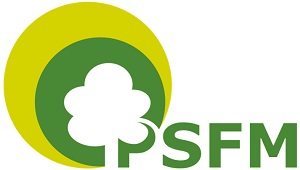PHÂN TÍCH ỨNG DỤNG GIS VÀ VIỄN THÁM TRONG THAY ĐỔI THẢM PHỦ RỪNG DƯỚI TÁC ĐỘNG CỦA CÁC NHÂN TỐ TỰ NHIÊN, KINH TẾ VÀ XÃ HỘI
Từ khóa:
GIS và viễn thám, LULCC, nhân tố tự nhiên - kinh tế - xã hộiTóm tắt
Bài viết này tổng hợp và phân tích các công trình nghiên cứu về ứng dụng công nghệ GIS và viễn thám trong việc theo dõi và phân tích thay đổi thảm phủ sử dụng đất (LULCC), quản lý tài nguyên rừng và mối quan hệ giữa thay đổi tài nguyên rừng với các nhân tố tự nhiên - kinh tế - xã hội. Tổng quan từ 79 tài liệu trong và ngoài nước cho thấy, các nghiên cứu trước đây chủ yếu tập trung vào phân tích LULCC theo giai đoạn và ít khám phá sâu vào tác động tổng hợp của các nhân tố tự nhiên, kinh tế và xã hội. Bài viết mở rộng phạm vi nghiên cứu bằng cách đánh giá các nghiên cứu liên quan đến tác động của những nhân tố này đối với thay đổi thảm phủ rừng, chỉ ra các thách thức liên quan không chỉ xuất phát từ các yếu tố tự nhiên mà còn từ ảnh hưởng lớn của các yếu tố kinh tế và xã hội. Về phương pháp các nghiên cứu trên toàn cầu đã sử dụng công nghệ viễn thám và GIS để xem xét tác động của các nhân tố tự nhiên, kinh tế và xã hội đến LULCC, dựa trên phương pháp hồi quy tuyến tính, trong khi đó chỉ một số ít đã áp dụng mô hình phương trình cấu trúc (Strutural Equation Modeling) với một vài nhân tố được xác định một cách chủ quan để phân tích định lượng mối quan hệ nhân quả này. Tại Việt Nam, nghiên cứu về tác động của các nhân tố tự nhiên, kinh tế và xã hội đến thay đổi thảm phủ rừng sử dụng công nghệ viễn thám và GIS còn hạn chế, thường tập trung vào phân tích riêng lẻ các nhân tố hoặc kết hợp một vài nhân tố, với phương pháp chính là hồi quy tuyến tính hoặc logistic. Việc tổng quan các ứng dụng này nhằm làm cơ sở để vận dụng phối hợp không chỉ phân tích định lượng và không gian LULCC mà còn chỉ ra tiềm năng ứng dụng phân tích này trong mối tương quan với các yếu tố kinh tế - xã hội.
Tài liệu tham khảo
Abdurrahman, L., Mulyana, R., 2022. “Pemodelan nilai teknologi informasi menggunakan structural equation modeling (SEM)”. JIP (jurnal ilmiah penelitian dan pembelajaran informatika), Vol 7, Issue 2, pp. 469-477, 2022. https://doi.org/10.29100/jipi.v7i2.2825.
Adegun, A.A., Viriri, S. & Tapamo, JR, 2023. “Review of deep learning methods for remote sensing satellite images classification: experimental survey and comparative analysis”. J Big Data 10, 93 (2023). https://doi.org/10.1186/s40537-023-00772-x.
Aide, T. M., Grau, H. R., Graesser, J., Andrade-Nuñez, M. J., Aráoz, E., Barros, A. P.,... Zimmerer, K. S., 2019. Woody vegetation dynamics in the tropical and subtropical Andes from 2001 to 2014: Satellite images interpretation and expert validation. Global Change Biology, 25, 2112-2126. https://doi.org/10.1111/gcb.14618.
Almalki, R., Khaki, M., Saco, P.M., Rodriguez, J.F., 2022. “Monitoring and Mapping Vegetation Cover Changes in Arid and Semi-Arid Areas Using Remote Sensing Technology: A Review”. Remote Sens. 2022, 14(20), 5143; https://doi.org/10.3390/rs14205143.
Amini, S., Saber, M., Dastjerdi, H.R., Homayouni, S., 2022. “Urban Land Use and Land Cover Change Analysis Using Random Forest Classification of Landsat Time Series”. Remote Sens. 2022, 14(11), 2654; https://doi.org/10.3390/rs14112654.
Angelstam, P., Khaulyak, O., Yamelynets, T., Mozgeris, G., Naumov, V., Chemielewski, T.J., Elbakidze, M., Manton, M., Prots, B., Valasiuk, S., 2017. “Green infrastructure development at European Union's eastern border: Effects of road infrastructure and forest habitat loss”. Journal of Environmental management, Volume 193, https://doi.org/10.1016/j.jenvman.2017.02.017.
Anca Antoaneta Vărzaru and Claudiu George Bocean, 2023. An Empirical Analysis of Relationships between Forest Resources and Economic and Green Performances in the European Union. Forests, vol 14(12), doi: 10.3390/f14122327.
Baehr, A., BenYishay, A., Parks, A., 2021. “Linking Local Infrastructure Development and Deforestation: Evidence from Satellite and Administrative Data”. Journal of the Association of environmental and resource economists, Vol 8, number 2.
Trần Quang Bảo, Nguyễn Đức Lợi, Lã Nguyên Khang, 2017. Ứng dụng GIS và viễn thám trong phân tích thực trạng và đánh giá diễn biến tài nguyên rừng tại huyện Vĩnh Cửu, tỉnh Đồng Nai. Tạp chí Khoa học và công nghệ Lâm nghiệp, số 6, 2017.
Bartold, M. & Kluczek, M., 2023. “A Machine Learning Approach for Mapping Chlorophyll Fluorescence at Inland Wetlands”. Remote Sens. 2023, 15(9), 2392; https://doi.org/10.3390/rs15092392.
Bebbington, A.J., Bebbington, D.H., Sauls, L.A., Rogan, J., Agrawal, S., Gamboa, C., Imhof, A., Johnson, K., Rosa, H., Royo, A., Toumbourou, T., Verdum, R., 2018. “Resource extraction and infrastructure threaten forest cover and community rights”. Crossref, December 3, 2018, 115 (52) 13164-13173 https://doi.org/ 10.1073/pnas.1812505115.
Blaga, L., Llies, D.C., Wendt, J.A, Rus, L., Zhu, K., Dávid, L.D., 2023. “Monitoring Forest Cover Dynamics Using Orthophotos and Satellite Imagery”. Remote Sens. 2023, 15(12), 3168; https://doi.org/10.3390/rs15123168.
Borda-Nĩno, M., Meli, P., Brancalion, P.H.S., 2019. “Drivers of tropical forest cover increase: A systematic review”. Land degradation & Development, volume 31, issue 11, https://doi.org/10.1002/ldr.3534.
Börner, J; Baylis, K.; Corbera, E.; Ezzine-de-Blas, D.; Ferraro, P.J.; Honey-Rosés, J.; Lapeyre, R.; Persson, U.M.; Wunder, S., 2016. Emerging Evidence on the Effectiveness of Tropical Forest Conservation. Plos one, https://doi.org/10.1371/journal.pone.0159152.
Cuaresma, C. J., Danylo, O., Fritz S., McCallum, L., Obersteiner, M., See, L., Walsh, B., 2017. “Economic Development and Forest Cover: Evidence from Satellite Data”. Scientific Reports, 7, 40678. https://doi.org/ 10.1038/srep40678.
David, J.K., 2020. Can roads contribute to forest transitions? World development, vol 129. https://doi.org/10.1016/ j.worlddev.2020.104898.
Debebe, B., Senbeta, F., Teferi, E., Guta, D., 2023. “Analysis of Forest Cover Change and Its Drivers in Biodiversity Hotspot Areas of the Semien Mountains National Park, Northwest Ethiopia”. Sustainability 2023, 15, 3001. https:// doi.org/10.3390/su15043001.
DeFries, R., Rudel, T., Uriarte, M., & Hansen, M., 2010. “Deforestation driven by urban population growth and agricultural trade in the twenty-first century”. Nature Geoscience, 3(3), 178-181. https://doi.org/ 10.1038/ngeo756.
Duguma, L.A., Atela, J., Minang, P.A., Ayana, A.N., Gizachew, B., Nzyoka, J.M., Bernard, F., 2019. “Deforestation and forest degradation as an environmental behavior: Unpacking realities shaping community actions”. Land 2019, 8(2), 26; https://doi.org/10.3390/land8020026.
Fassnacht, F.E., White, J.C., Wulder, M.A., Næsset, E., 2024. “Remote sensing in forestry: current challenges, considerations and directions,” Forestry: An International Journal of Forest Research, Volume 97, Issue 1, January 2024, Pages 11-37, https://doi.org/10.1093/forestry/cpad024.
FAO, 2020. “Global Forest Resources Assessment 2020”. Rome, Italy, ISBN 978-92-5-132581-0.
Furukawa, T., Tsujino, R., Kitamura, S., Yumoto, T., 2018. “Factors affecting forest area change in Southeast Asia during 1980-2010”. PLOS ONE 13(6): e0199908. https://doi.org/10.1371/journal.pone.0199908.
Furumo PR, Lambin EF. Policy sequencing to reduce tropical deforestation. Global Sustainability, 2021. 4:e24. doi:10.1017/sus.2021.21.
Gan, Y., Wang, Q., Lio, A., 2023. “Tree Crown Detection and Delineation in a Temperate Deciduous Forest from UAV RGB Imagery Using Deep Learning Approaches: Effects of Spatial Resolution and Species Characteristics”. Remote Sens. 2023, 15(3), 778; https://doi.org/10.3390/rs15030778.
Goetz, S.J., Hansen, M., Houghton, R.A., Walker, W., Laporte, N., Busch, J., 2015. “Measurement and monitoring needs, capabilities and potential for addressing reduced emissions from deforestation and forest degradation under REDD+”. IOP Publishing, 10(12), DOI:10.1088/1748-9326/10/12/123001.
Global Forest Watch., 2023. “Tropical Primary Forest Loss Worsened in 2022, Despite International Commitments to End Deforestation”. Global Forest Watch Report 2023.
Gu, Z. & Zeng, M., 2024. “The Use of Artificial Intelligence and Satellite Remote Sensing in Land Cover Change Detection: Review and Perspectives”. Sustainability 2024, 16(1), 274; https://doi.org/ 10.3390/su16010274.
Helming, K., Diehl, K., Kuhlman, T., Jansson, T., Verburg, P.H., Bakker, M., Perez-Soba, M., Jones, L., Verkerk, P.J., Tabbush, P., Morris, J.B., Drillet, Z., Farrington, J., LeMouël, P., Zagame, P., Stuczynski, T., Siebielec, G., Wiggering, H., 2011. “Ex ante impact assessment of policies affecting land use, Part B: application of the analytical framework”. Ecology and Society 16(1): 29. [online] URL: http://www.ecologyandsociety.org/ vol16/iss1/art29/
Cao Thị Hoài và Nguyễn Thị Thanh Hương, 2024. Phân tích sự thay đổi lớp phủ ở huyện Đắk Glong - tỉnh Đắk Nông giai đoạn 2011-2023 dựa vào ảnh vệ tinh đa thời gian. Tạp chí Khoa học Lâm nghiệp, số 01, 2024.
Huang, C.; Zhang, C.; Li, H., 2022. Assessment of the Impact of Rubber Plantation Expansion on Regional Carbon Storage Based on Time Series Remote Sensing and the InVEST Mode. Remote Sens. 2022, 14(24), 6234; https://doi.org/10.3390/rs14246234.
Đặng Ngọc Hưng, Hồ Đắc Thái Hoàng, 2009a. Nghiên cứu sự thay đổi lớp phủ thảm thực vật rừng tại Vườn quốc gia Bạch Mã, tỉnh Thừa Thiên - Huế, Tạp chí Kinh tế sinh thái, số 32.
Đặng Ngọc Hưng và Hồ Đắc Thái Hoàng, 2009b. Ứng dụng GIS và viễn thám trong nghiên cứu thay đổi lớp phủ đất và rừng. Journal of Environmental Science and Technology.
Nguyễn Thị Thanh Hương, Châu Thị Như Quỳnh, Nguyễn Đức Định, Phan Thị Hằng, Cao Thị Hoài, Nguyễn Thế Hiển, Đặng Ngọc Trí, Ngô Thế Sơn, Đoàn Minh Trung, Hồ Đình Bảo, Ngô Thị Thùy Phương, Nguyễn Công Tài Anh, Võ Hùng, Hoàng Trọng Khánh, 2018. Thử nghiệm định lượng đa dạng loài thực vật thân gỗ tại tỉnh Đắk Nông dựa vào ảnh vệ tinh. Tạp chí khoa học Tự nhiên và Công nghệ, Tập 15, Số 11b (2018): 54-62. ISSN: 1859-3100.
Nguyễn Thị Thanh Hương và Ngô Thị Thùy Phương, 2019. Phân tích thay đổi thảm phủ dựa vào ảnh vệ tinh đa thời gian và chuỗi Markov tại tỉnh Đắk Nông. Tạp chí Khoa học Lâm nghiệp, số 2, tr. 101-112.
Jayathilake, H. M.; Wei C. Z.; Tan, G.; Porte, C.; Carrasco, L. R., 2024. Rubber plantation size and global rubber price are linked to forest loss and degradation in Jambi, Sumatra. Integrative conservation, Vol 3, Issue 1, p. 22-35. https://doi.org/10.1002/inc3.43.
Jeganathan, C. and Atkinson, P.M., 2010. Mapping the phenology of natural vegetation in India using a remote sensing-derived chlorophyll index. International Journal of Remote Sensing, Volume 31, 2010 - Issue 22.
Jia, M., Wang, Z., Zang, Y., 2015. “Landsat-Based Estimation of Mangrove Forest Loss and Restoration in Guangxi Province, China, Influenced by Human and Natural Factors”. IEEE Journal of Selected Topics in Applied Earth Observations and Remote Sensing, vol. 8, no. 1, Jan. 2015, pp. 311-23, doi:10.1109/ JSTARS.2014.2333527.
Kobayashi, S., Fujita, M.S., Omura, Y., Haryadi, D.S., Muhammad, A., Irham, M., Shiodera, S., 2023. “Evaluating Threatened Bird Occurrence in the Tropics by Using L-Band SAR Remote Sensing Data”. Remote Sens. 2023, 15(4), 947; https://doi.org/10.3390/rs15040947.
Krawczyk, W. & Wężyk, P., 2023. “Using Satellite Imagery and Aerial Orthophotos for the Multi-Decade Monitoring of Subalpine Norway Spruce Stands Changes in Gorce National Park, Poland”. Remote Sens. 2023, 15(4), 951; https://doi.org/10.3390/rs15040951.
Kumar, D., 2011. “Monitoring Forest Cover Changes Using Remote Sensing and GIS: A Global Prospective”. Research Journal of Environmental Sciences, 5: 105-123. https://doi.org/10.3923/rjes.2011.105.123.
Laze, K., 2022. “Preliminary findings on remote sensing of forest cover change, forest and tree health in Southeastern Europe”. International Archives of the Photogrammetry, Remote Sensing, and Spatial Information Sciences. Vol. XLIII-B4-2022.
Lee, J., 2015. “Satisfaction Factors Analysis of Freight Drivers Using Structural Equation Model”. Master’s Thesis, Hanyang University, Seoul, Korea.
Lee, S.H., Han, K.J., Lee, K., Lee, K.J., Oh, K.Y., Lee, M.J., 2020. “Classification of Landscape Affected by Deforestation Using High-Resolution Remote Sensing Data and Deep-Learning Techniques”. Remote Sens. 2020, 12(20), 3372; https://doi.org/10.3390/rs12203372.
Li, W., MacBean, N., Ciais, P., Defourny, P., Lamarch, C., Houghton, R.A., Peng, S., 2018. “Gross and Net Land Cover Changes in the Main Plant Functional Types Derived from the Annual ESA CCI Land Cover Maps (1992-2015)”. Earth System Science Data, vol. 10, no. 1, Jan. 2018, pp. 219-234, doi:10.5194/essd-10-219-2018.
Ling, Z.; Shi, Z.; Gu, S.; Wang, T.; Zhu, W.; Feng, G., 2022. Impact of Climate Change and Rubber (Hevea brasiliensis) Plantation Expansion on Reference Evapotranspiration in Xishuangbanna, Southwest China. Front. Plant Sci., 03 March 2022 Sec. Sustainable and Intelligent Phytoprotection, Volume 13, https://doi.org/ 10.3389/fpls.2022.830519.
Manson, S., Bonsal, D., Kernik, M., Lambin, E.F., 2015. “Geographic Information Systems and Remote Sensing”. International Encyclopedia of the Social & Behavioral Sciences, p64-68, DOI:10.1016/B978-0-08-097086-8.91027-4.
Marisa, S., 2022. “Reliabilitas konstruk multidimensional pada structural equation modeling (SEM)”. Akrab Juara, Vol 7, Issue 1, 2022. https://doi.org/10.58487/akrabjuara.v7i1.1783.
Marlin, M., 2018. “Structural Equation Modeling (SEM): Bergunakah bagi Penelitian Akuntansi”. Journal of Islamic accounting and tax, Vol 1, Issue 2, p. 134, 2018. https://doi.org/10.30587/jiatax.v1i2.761.
Maxwell, A.E., Warner, T.A., Guillén, L.A., 2021. “Accuracy Assessment in Convolutional Neural Network-Based Deep Learning Remote Sensing Studies-Part 1: Literature Review”. Remote Sens. 2021, 13(13), 2450; https://doi.org/10.3390/rs13132450.
Molla, G., Addisie, M.B., Ayele, G.T., 2023. “Expansion of Eucalyptus Plantation on Fertile Cultivated Lands in the North-Western Highlands of Ethiopia”. Remote Sens. 2023, 15(3), 661; https://doi.org/10.3390/rs15030661.
Na, H.S., Park, J., 2015. “Analysis of Land Cover Classification and Pattern Using Remote Sensing and Spatial Statistical Method”. J Korean Assoc Geogr Inf Stud NA, Hyun-Sup, Vol 18, Issue 4, pp. 100-118, 2015. Doi: https://doi.org/10.11108/kagis.2015.18.4.100.
Negassa, M.D., Mallie, D.T. & Gemeda, D.O, 2020. “Forest cover change detection using Geographic Information Systems and remote sensing techniques: a spatio-temporal study on Komto Protected forest priority area, East Wollega Zone, Ethiopia”. Environ Syst Res 9, 1. https://doi.org/10.1186/s40068-020-0163-z.
Ningthoujam, R., Tansey, K., Balzter, H., Morrison, K., Johnson, S.C.M., Gerard, F., George, C., Burbridge, G., Doody, S., Veck, N., Llewllyn, G.M., Blythe, T., 2016. “Mapping Forest Cover and Forest Cover Change with Airborne S-Band Radar”. Remote Sens. 2016, 8(7), 577; https://doi.org/10.3390/rs8070577.
N.T.T. Huong, 2011. Thesis Ph.D.: Classification of normal and natural wide-wide forests based on multi-data for forest control in the central Highlands. Freiburg im Breisgau, Germany.
N.T.T. Huong, C.T.N. Quynh, P.T. Anh, P.T. Hang, T.T.X. Phan, C.T. Hoai, L.Q. Toan, N.T.H. Diep, 2020. “Land use/land cover changes using multi-temporal satellite”. ISPRS TC IV Gi4DM 2020-13th GeoInformation for Disaster Management conference. Volume VI-3/W1-2020. Doi 10.5194/isprs-annals-VI-3-W1-2020-83-2020.
N.T.T. Huong, C.T.N. Quynh, P.T. Anh, P.T. Hang, T.T.X. Phan and T M T Pham, 2021. “Mapping Land use/land cover using a combination of Radar Sentinel -1A and Sentinel-2A optical images”. IOP Conference Series: Earth and Environmental Science, Volume 652, issue 1, https://doi.org/10.1088/1755-1315/652/1/012021.
Ottah, C. & Ukpere, D., 2018. “Remote sensing and GIS application in environmental management”. Chapter 16, Journal of Environmental Management.
Pettorelli, N., Safi, K., Turner, W., 2014. “Satellite Remote Sensing for Biodiversity Research and conservation of the future”. Biodiversity Sciences Journal. https://doi.org/10.1098/rstb.2013.0190.
Phompila, C., Lewis, M., Ostendorf, B., Clark Sandker e, K, 2017. “Forest Cover Changes in Lao Tropical Forests: Physical and Socio-Economic Factors are the Most Important Drivers”. Land 2017, 6(2), 23; https://doi.org/10.3390/land6020023.
Prochazka, P., Abrham, J., Cerveny, J., Kobera, L., Sanova, P., Benes, D., Fink, J., JirasKova, E., Simona, P., Soukupava, J., Smutka, L., 2023. “Understanding the socio-economic causes of deforestation: a global perspective”. Forest Management, Volume 6 - 2023. https://doi.org/10.3389/ffgc.2023.1288365.
Rovani, I.L., Decian, V.S., Zanin, E.M., Brandalise. M., Quadros, F.R., Hepp, L.U., 2020. “Socioeconomic Changes and Land Use and Land Cover of the Northern Region of Rio Grande do Sul, Brazil”. Floresta Ambient. 27 (3) • 2020 • https://doi.org/10.1590/2179-8087.025818.
Sandker, M., Carrilllo, O., Leng, C., Lee, D., Annuzio, R., Fox, J., 2021. “The Importance of High-Quality Data for Redd+ monitoring and reporting”. Forests 2021, 12(1), 99; https://doi.org/10.3390/f12010099.
Schultz, C.A., McIntyre, K.B., Cyphers, L., Kooistra, C., Ellson, A., Moseley, K., 2018. “Policy Design to Support Forest Restoration: The Value of Focused Investment and Collaboration”. Forests 2018, 9(9), 512; https://doi.org/10.3390/f9090512.
Shimamoto, C. Y., Padial, A. A., da Rosa, C. M., & Marques, M. C. M. 2018. Restoration of ecosystem services in tropical forests: A global meta-analysis. PLoS One, 13, 1-16. https://doi.org/10.1371/journal.pone.0208523.
Song, X.-P., Hansen, M. C., Stehman, S. V., Potapov, P. V., Tyukavina, A.,Vermote, E. F., & Townshend, J. R., 2018. Global land change from 1982 to 2016. Nature, 560, 639-643. https://doi.org/10.1038/s41586-018-0411-9.
Suleiman, M.S., Wasonga, O.V., Mbau, J.S., Elhadi, Y.A., 2017. “Spatial and temporal analysis of forest cover change in Falgore Game Reserve in Kano, Nigeria”. Ecol Process 6, 11 (2017). https://doi.org/10.1186/s13717-017-0078-4.
Tandetzki, J., Schier, F., Kothle, M,, Weimar, H., 2022. “An evidence and gap map of the environmental Kuznets curve and the forest transition hypothesis for estimating forest area development,” Environ. Res. Lett. 17 123005, DOI 10.1088/1748-9326/aca781.
Phạm Phương Thảo và Trần Nam Thắng, 2022. Kết hợp số liệu thay đổi mục đích sử dụng rừng và theo dõi diễn biến rừng tại huyện Nam Đông: Phương pháp và ứng dụng. Journal of Forestry Research.
Nguyễn Văn Thị, Trần Thị Mai Anh, Nguyễn Thị Hà, Phùng Văn Khoa, Vũ Tiến Thịnh, 2016. Ứng dụng GIS và viễn thám trong quản lý chi trả dịch vụ môi trường rừng tại lưu vực thủy điện Hương Sơn, Hà Tĩnh. Tạp chí Khoa học và công nghệ Lâm nghiệp, số 6, 2016.
Lê Quang Toan, 2021. Nghiên cứu ứng dụng công nghệ viễn thám và GIS trong đánh giá tổng hợp tài nguyên thiên nhiên và môi trường, phát triển kinh tế xã hội và du lịch tỉnh Đắk Nông. Đề tài cấp Bộ, Bộ Khoa học và Công nghệ.
Phạm Quang Vinh, Vũ Thị Kim Dung, 2016. Ứng dụng công nghệ viễn thám và GIS đánh giá biến động tài nguyên rừng ở tỉnh Điện Biên. Tạp chí Khoa học Công nghệ Việt Nam, số 3(3), 2016.
Wu, X.; Liu, G.; Bao, Q., 2023. Impact of economic growth on the changes in forest resources in Inner Mongolia of China. Front. Environ. Sci., 02 August 2023, Sec. Environmental Economics and Management, Volume 11. https://doi.org/10.3389/fenvs.2023.1241703.
Woldemedhin, D.G., Assefa, E., Seyoum, A., 2022. “Forest Covers, Energy Use, and Economic Growth Nexus in the Tropics: A Case of Ethiopia”. Trees, forests and people, Volume 8, https://doi.org/10.1016/j.tfp.2022.100266.
Xu, C., Du, X., Yan, Z., Fan, X., 2020. “ScienceEarth: A Big Data Platform for Remote Sensing Data Processing”. Remote sensing, Vol. 12 Issue 4, p. 607, 2020. Doi: 10.3390/rs12040607.
Xu, L., Herold, M., Tsendbazar, N., Masiliūnas, D., Li, L., Lesiv, M., Fritz, S., Verbesselt, J, 2022. “Time series analysis for global land cover change monitoring: A comparison across sensors”. Remote Sensing of Environment, Vol. 271, p. 112905, 2022. DOI https://doi.org/10.1016/j.rse.2022.112905.
Yang, J., Gong, P., Fu, R., Zhang, M., Chen, J., Liang, S., Xu, B., Shi, J., Dickinson, R., 2013. “Erratum: The role of satellite remote sensing in climate change studies”. Nature Clim Change 3, 1001 (2013). https://doi.org/10.1038/nclimate2033.
Zhang, G., Hormann, G., Huang, J., Fohrer, N., 2023. “Identifying Drivers of Forest Cover Change in Developing Countries Through Remote Sensing”. Remote Sens. 2023, 15(8), 2128; https://doi.org/10.3390/rs15082128.
Zhao, S., Liu, M., Tao, M., Zhou, W., Lu, X., Xiong, Y.J., Li, F., Wang, Q., 2023. “The role of satellite remote sensing in mitigating and adapting to global climate change”. The Science of The Total Environment 904(6247):166820 https://doi.org/10.1016/j.scitotenv.2023.166820.
Zhou, T., 2011. “Understanding online community user participation: A social influence perspective”. Internet Res, 21, 67-81.













